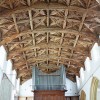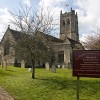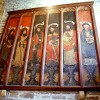Celia Fiennes was born on June 9th 1662 in the manor-house at Newton Toney near Salisbury and died in 1741 at the age of 79. She inherited Puritan and Parliamentary sentiments from her parents: her father was Colonel Nathaniel Fiennes who served Cromwell as a member of the Council of State and as Keeper of the Great Seal. Her grandfather, who died the year she was born, was William Fiennes the 1st Viscount Saye and Sele; he had been a staunch Parliamentarian but he was also in favour of negotiating a settlement with the King. He accepted the Restoration in 1660 and was appointed a Privy Councillor to King Charles II.
Celia Fiennes is remembered today largely because of a travelogue she wrote as she toured the country on horseback. Travelling the length and breadth of the country from Hadrian’s Wall to Land’s End and from Yarmouth to Shrewsbury her words were intended for her near relatives but in 1888 Robert Southey and Mrs Emily Griffiths published Celia Fiennes work as: “Through England on a Side Saddle in the Time of William and Mary”.
Poole and Brownsea
In Part 1 of her Journeys (c. 1685-1696) she comes to Dorset from Salisbury and Wilton and on arrival has this to say: “I went to Blandford in Dorsetshire 18 miles through a hare warren and a forest of the kings – (Cranbourne Chase) – Blandford is a pretty neate country town – thence to Merley by Wimborne over a great river called the Stoure by a large arched bridge to a relation’s house, Sir William Constantines – thence to Poole a little sea-port town 4 miles off where was a very good Minister in the publick church Mr Hardy”.
From Poole, Celia went to Brownsea Island, about which she has this to say: “We went by boate to a little Isle called Brownsea where there is much Copperice made, the stones being found about the Isle in shore in great quantetyes, there is only one house there which is the Governours, besides little fishermens houses, they all being taken up about the Copperice works…This a noted place for lobsters and crabs and shrimps, there I eate some very good”. The Copperice that Celie Fiennes refers to is a sulphate of iron or green vitriol which was used in the dyeing industry and the manufacture of inks.
The Isle of Purbeck
“From Merly we went to the Isle of Purbeck. At Warrum (Wareham) we passed over a bridge where the sea flowed in and came by the ruins of Corfe Castle,which stands on a hill yet surrounded by much higher hills that might easily command it, and so in the Civil wars was batter’d down with Granadeers, thence you rise a great ascent of hills called the Linch (Lynch), or rather the ridge, being so for 3 or 4 miles, rideing to Quare (Quar) which was 16 miles from Merly to a relations house Cos’n Colliers”.
From the ridge Celia looked out over the Isle of Purbeck with its “pleasant meadows and woodlands” and she tells us of “many quarys in these hills of that which is called the free stone, from hence they dig it”. She tells us most of the houses on the island are built of stone.
Continuing, she says: “the shores are very rocky all about the island, we went three miles off to Sonidge (Swanage) a sea faire place not very big;… they take up stones by the shores that are so oyly as the poor burn it for fire, and it’s so light a fire it serves as candle too, but it has a strong offensive smell”.
From Swanage she journeyed on to “a place 4 miles off called Sea Cume (Seacombe) where she observes “it being a spring tide”; she saw the “craggy rockes” lashed by the billows of a turbulent sea and heard the caves of that coast reverberate the sound of the waves “like some hall or high arch”. Celia notes that “In this Island are several good houses” and mentions “At Kingston Sir William Muex (Meux) has a pretty house and att Income (Encombe) Mr. Coliffords, Doonshay (Downshay), Mr Dollings, and 7 miles off Quare at Tinnum (Tyneham) Lady Lawrences there is a pretty large house but very old timber built”. This place was especially agreeable to Celia and she tells us: “there I eate the best lobsters and crabs being boyled in the sea water and scarce cold, very large and sweet”.
From Tyneham she travelled north-west to Bindon, Piddletrenthide, “…where was a relation Mr Oxenbridge” and then on to Dorchester which “stands on the side of a hill, the river runs below it, the town looks compact and the streets are very neately pitch’d (paved) and of a good breadth, the Market-lace is spacious, the Church very handsome and full of galleryes”.
Bridport and Lyme Regis
She continued travelling westward until she came to Burport (Bridport). “The ways are stony and very narrow, the town has a steep hill to descend through the whole place: thence to Woolfe(?) to a relations Mr Newbery”. She describes this gentleman as “a man of many whymseys, would keep no women servants, had all the washing, ironing and dairy etc., all performed by men: his house looks like a little village when you come into the yard, so many little buildings apart from each other”. One of these was a “stillatory” (still-house), another a “long building for silk wormes”. But, she says, all was “in a most rude confused manner”.
From Mr Newbery she travelled to another relation, Mr Henlys, at Colway near Lime (Lyme Regis). In her writing Celia Fiennes wrongly places Lyme Regis in Somersetshire. For her the most interesting feature of this “seaport place open to the main ocean” was the “Cobb or Halfe Moon”.
She observes the residents of the town have to contend with “…so high a bleake sea that to secure the Harbour for shipps they have at a great charge to build a Mold from the town with stone, like a halfe moon, which they call the Cobb, its raised with a high wall and this runns into the sea a good compass, that the Shipps ride safely within it: when the tide is out we may see the foundations of some part of it; that is the tyme they looke over it to see any breach and repair it immediately, else the tide comes with so great violence would soon beate it down”. Celia mentions that the Springtide “does sometimes beate up and wash over the walls of the forte and so runns into the town”.
After taking a step into Somerset she starts her return journey commenting as she often does on the condition of the roads: “From Lime the ways are difficult by reason of the very step hills up and down, and that so successfully as little or no plaine even ground, and full of large smooth pebbles that make the strange horses slip and uneasye to go; the horses of the country are accustomed to it and travel well in the rodes…”
Footnote: George Roberts in his History of Lyme Regis (1823) traces the history of the manor of Colway and says: “It has become the property of the Henly family who lived there in great style for many years. The house was large, and a road between two rows of stately trees, which have been long since cut down, led to the church, to which some affirm there is now a subterraneous passage. The house has gone to decay – some of the ruins are visible at the back of the present farmhouse. No courts are held nor any symbols of a manor preserved”.
To be continued…



